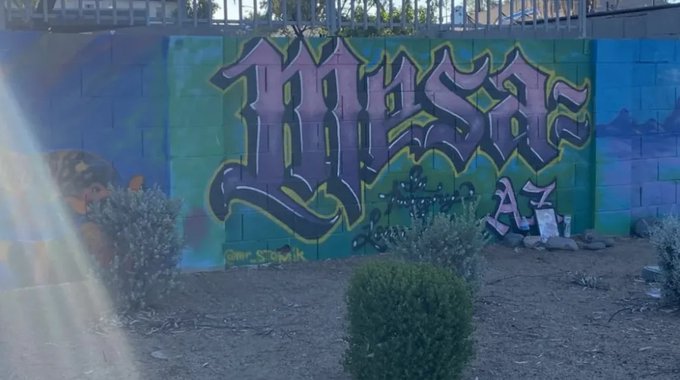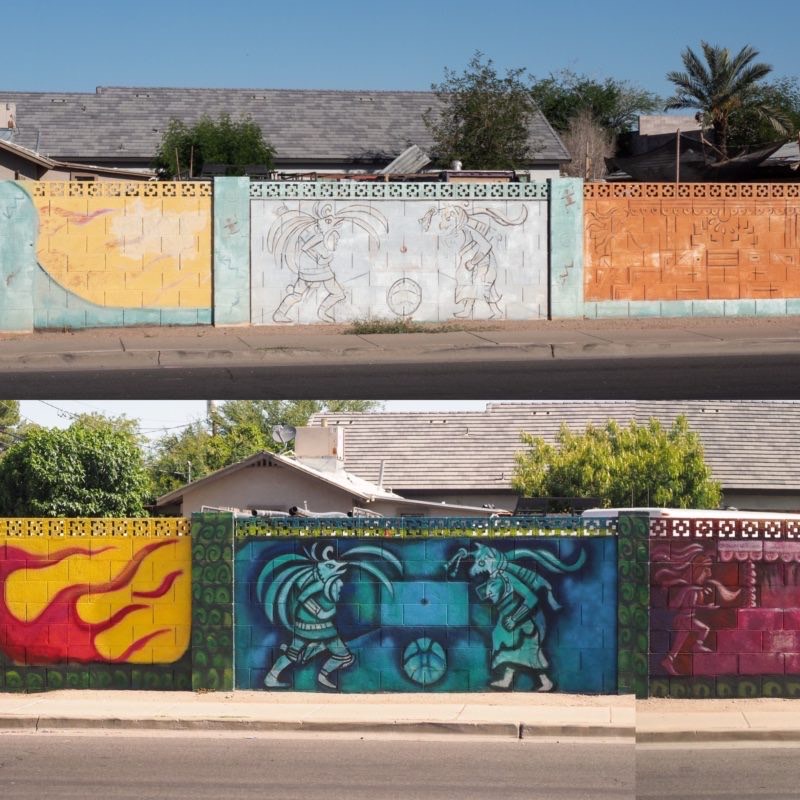The historic Latino-majority communities of Southside Mesa, AZ have endured decades of disinvestment - and are now faced with potential displacement. With support from the grassroots community development group RAIL (for Retail, Arts, Innovation and Livability), a longtime LISC partner, residents and other stakeholders are strategizing and taking the reins of the future of their neighborhoods. To close out our commemoration of Hispanic/Latinx Heritage Month, we took a look at how Southside Mesa is making it happen, this month and every month.
For generations, Latino families have been the keepers of the tight-knit neighborhoods just south of downtown Mesa, AZ.
Over decades, they’ve run small businesses along the area’s commercial corridors of Main Street and Broadway Road, and raised children in the low-slung houses of its residential streets. As young poets from a local after-school program describe Southside Mesa, it’s a place where the scent of charcoal and carne asada fills the air on weekends, and “mom and dad, abuela, tíos y tías/brothers, sisters, cousins, and friends who are family/Fill the yard with love/And kindness and yelling and music.”
But Hispanic/Latino people don’t actually own many of the buildings where all this life takes place. And with more than $1 billion in high-end development now coming to downtown Mesa, that lack of economic and political pull puts them at risk of displacement.
“The threat of gentrification is right in front of us,” says Augie Gastelum, lead consultant for the nonprofit RAIL Community Development Corporation (RAIL CDC).

RAIL is a tiny shop driven by the outsize energies of Gastelum and founder-executive director Ryan Winkle. They’ve spent their lives in and around the communities with which they work. And they’re determined to help build power there by bringing folks together to tackle problems and celebrate the neighborhoods’ family-centered Latin culture.
A place at a turning point
For a long time, the spaces where Mesa’s orange pickers and other migrant workers first settled before the Second World War were not much coveted. Just as Black people were segregated in a neighborhood to the north of downtown, immigrants from Mexico and later other parts of Latin America were relegated to unmaintained dwellings to the south.

Today, the Southside neighborhoods are more than 70 percent Latino and overwhelmingly BIPOC. Nearly 4 in 10 residents were born in other countries. Most speak Spanish as a first language. Median household income is less than $32,500.
And while the city and Arizona State University have collaborated on a new $100 million ASU campus for Mesa’s long-underinvested downtown—and thousands of units of market-rate and luxury housing, some spearheaded by the Church of Jesus Christ of Latter-day Saints, are in various stages of completion, construction, and planning in the urban core—investment hasn’t yet landed directly in Southside communities.
Its sidewalks—where there are sidewalks—are crumbling. Its bus stops lack shelter against the intense Arizona sun. Absentee landlords—descendants of the same “pioneers,” says Winkle, who long ago pushed out the area’s Native peoples and set the parameters of the Hispanic district—hold Southsiders’ homes under trusts and limited liability corporations, often letting them fall into serious disrepair.
What’s more, Gastelum and Winkle perceive in the city’s recent stepped-up code enforcement and policing in Spanish-speaking Southside neighborhoods (along with its rejection of proposed affordable housing there) a policy to “clean up” the area that will have the effect of displacing current residents, even if that’s not the intention.
RAIL is one of those organizations that isn’t afraid to get loud and push back.
An organization of the people
It began its work in 2012 as an informal association tasked with bringing diverse voices into planning for a transit line that now connects Mesa’s downtown with adjacent Tempe and Phoenix. With the support of LISC Phoenix RAIL formalized its status as a CDC in 2019 and hired its first employee. Boxing above its weight, this agile nonprofit helped hundreds of local business proprietors, the vast majority BIPOC-owned, access some $6.4 million in direct aid and technical assistance during 2020 and 2021 to survive the shocks of Covid-19.
Like its high-touch work with business owners, RAIL’s strategy for organizing residents takes a warm, bilingual, and culturally sensitive approach.
Last spring, for example, RAIL launched a series of casual pláticas (“conversations”) around the neighborhoods that met people where they naturally gather for relaxation and community. One happened in the yard of a family that sells tacos on weekends from their home kitchen. That day the tacos were on RAIL, and the talk, among a small group of people, was about a shared sense of place. At the next plática, dozens more showed up.

The conversations brought together some neighbors who’d never met, but also surfaced the profound commitment many residents feel to their home-base section of Mesa. “Their social fabric exists right there, whether it’s family members, the places that they know, the little bodegas. All of that fabric is there for them and they love it,” says Gastelum, who was born in Mexico and grew up in Mesa himself.
After each plática, RAIL invited participants to join in walking audits of familiar territory to notice assets as well as things that need to change—those sidewalks, for instance, not only crumbling but also lacking curb cuts for accessibility and strangely obstructed by utility posts and wellheads. Following the audits RAIL held community workshops to brainstorm prototype designs for small projects that could bring blessings such as shade and color to the neighborhoods.
For regional and national organizations that want to work in Southside communities, RAIL has become the go-to grassroots partner that understands how to connect with and listen to neighborhood people.
In spring 2017, for instance, the Nature Conservancy, Maricopa County Department of Public Health, and other partners launched a process to develop heat action plans for Greater Phoenix, where 110-degree days are not uncommon and are expected to more than double in frequency by the year 2060. The Southside’s Mesa Care neighborhood was selected as one of three hot-spot focus areas, all majority Latino. RAIL helped involve the neighborhood’s residents in discussions and workshops that drew out their experiences of urban heat, and what these advocates heard hardly surprised them. Residents want more cooling shade—trees and screens and shelters—and they want more water, the drinking fountains and kiddie splash pads that affluent communities enjoy.
These were useful topics to unravel. Unfortunately the process also ended up underlining the limits of power sharing when it doesn’t include a role in allocating resources. The city has not focused its greening program in the Mesa Care or other Southside neighborhoods. So residents who’d been eager to plant new trees were left wondering why they’d put time into the project. “There are still hurt feelings,” says Gastelum. “There were expectations that were not met. And that’s hard.”
Two years after the heat project began, the Urban Land Institute initiated a mural-making effort for the area around Guerrero Park, southeast of the Mesa Care neighborhood. RAIL encouraged the organization to go slow and take the steps necessary to truly involve local people. And that’s exactly what happened. One thing RAIL accomplished during this few-months’ period was to locate, by word of mouth, the artist who’d created an iconic but unsigned mural in the heart of the barrio.
Placekeeping with paint
A native of that locale, David Martinez had been right there all along. In 1981, as a twentysomething art student at ASU, he’d painted his mural on a concrete wall wrapping around a cluster of houses. He had help from his mom and sister and other community people, and collected funds for the project by passing a coffee can among neighbors.
Martinez’s idea, apart from finding an outlet for artistic expression amid slim opportunities, was to counter the gang tags that littered the wall in the early ‘80s. His mural features a bare-torsoed Christ with arms reaching out—“to protect the community,” says Martinez—as well as images of ancient Mesoamerica including Quetzalcoatl, a feathered serpent that like Jesus is associated with a dual nature at once animal and divine, a symbol of death and resurrection.

David Martinez's mural, which dates to the early 1980s and has become an emblem of the neighborhood for its residents, prior to refurbishing and after.
In refurbishing his work, part of a process that brought 20 other bright, fresh murals to the area, Martinez was moved to be reminded how deeply his neighbors identified with the painting he made 40 years ago. More than one person has told him they tattooed themselves with images from the wall. That includes a man who now lives in a wealthy part of Scottsdale but told Martinez, “I’m from Mesa, man.” As for Martinez, he still lives nearby and sees the painting every day.
Ultimately, in branding and convening the “Distrito Latino” of Mesa, the goal of Gastelum and Winkle and the handful of other consultants who work with RAIL is to give Southside people a way to be heard by city power holders—and a means, after many years of rent-paying, to secure their domiciles and business venues through affordable ownership. What’s needed, says Winkle, is nothing less than a fundamental “mental shift” that asserts the value of people over property.
That means honoring the human motivation that keeps Martinez, an artist with a day job working for a major bank, living in the house he grew up in. As he puts it, “I just have strong ties around here.”